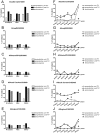Immunogenicity and cross-reactivity of 2009-2010 inactivated seasonal influenza vaccine in US adults and elderly
- PMID: 21304946
- PMCID: PMC3031605
- DOI: 10.1371/journal.pone.0016650
Immunogenicity and cross-reactivity of 2009-2010 inactivated seasonal influenza vaccine in US adults and elderly
Abstract
The campaign of 2009-2010 Northern Hemisphere seasonal vaccination was concurrent with the 2009 H1N1 pandemic. Using a hemagglutination inhibition (HAI) assay, we evaluated the immunogenicity and cross-reactivity of 2009-2010 inactivated trivalent influenza vaccine (TIV) in US adult and elderly populations. Vaccination of TIV resulted in a robust boost on the antibody response of all subjects to seasonal A/Brisbane/59/2007 (H1N1) and A/Uruguay/716/2007 (H3N2) with over 70% of recipients reaching a seroprotective titer of 40. B/Brisbane/60/2008 was the least immunogenic among the three seasonal vaccine strains with <30% of TIV recipients reaching a seroprotective titer of 40. TIV vaccination also induced a moderate boost on the pandemic specific antibody responses. Twenty-four percent of adults and 36% of elderly reached a seroprotective HAI titer of 40 or more against pandemic A/South Carolina/18/2009 (H1N1) after receiving TIV compared to 4% and 7% at the beginning of vaccination, respectively. In addition, 22% of adults and 34% of elderly showed an increase of 4-fold or more in A/South Carolina/18/2009 specific HAI titers after TIV vaccination. The pandemic specific cross-reactive antibodies strongly correlated with the post-vaccination HAI titers against the seasonal H3N2 vaccine strain in all subjects.
Conflict of interest statement
Figures



Similar articles
-
Immunogenicity of AS03-adjuvanted and non-adjuvanted trivalent inactivated influenza vaccines in elderly adults: A Phase 3, randomized trial and post-hoc correlate of protection analysis.Hum Vaccin Immunother. 2016 Dec;12(12):3043-3055. doi: 10.1080/21645515.2016.1219809. Hum Vaccin Immunother. 2016. PMID: 27690762 Free PMC article. Clinical Trial.
-
Antibody persistence and response to 2010-2011 trivalent influenza vaccine one year after a single dose of 2009 AS03-adjuvanted pandemic H1N1 vaccine in children.Vaccine. 2011 Dec 9;30(1):35-41. doi: 10.1016/j.vaccine.2011.10.062. Epub 2011 Nov 7. Vaccine. 2011. PMID: 22063386
-
Response to 2009 pandemic influenza A (H1N1) vaccine in HIV-infected patients and the influence of prior seasonal influenza vaccination.PLoS One. 2011 Jan 31;6(1):e16496. doi: 10.1371/journal.pone.0016496. PLoS One. 2011. PMID: 21304982 Free PMC article. Clinical Trial.
-
Absence of cross-reactive antibodies to influenza A (H1N1) 2009 before and after vaccination with 2009 Southern Hemisphere seasonal trivalent influenza vaccine in children aged 6 months-9 years: a prospective study.Influenza Other Respir Viruses. 2011 Jan;5(1):7-11. doi: 10.1111/j.1750-2659.2010.00172.x. Epub 2010 Aug 24. Influenza Other Respir Viruses. 2011. PMID: 21138535 Free PMC article. Clinical Trial.
-
Immunogenicity of a 2009 pandemic influenza virus A H1N1 vaccine, administered simultaneously with the seasonal influenza vaccine, in children receiving chemotherapy.Pediatr Blood Cancer. 2014 Jun;61(6):1013-6. doi: 10.1002/pbc.24893. Epub 2014 Jan 3. Pediatr Blood Cancer. 2014. PMID: 24395342 Clinical Trial.
Cited by
-
Cross-lineage influenza B and heterologous influenza A antibody responses in vaccinated mice: immunologic interactions and B/Yamagata dominance.PLoS One. 2012;7(6):e38929. doi: 10.1371/journal.pone.0038929. Epub 2012 Jun 22. PLoS One. 2012. PMID: 22745690 Free PMC article.
-
The antibody response to influenza vaccination is not impaired in type 2 diabetics.Vaccine. 2015 Jun 26;33(29):3306-13. doi: 10.1016/j.vaccine.2015.05.043. Epub 2015 Jun 1. Vaccine. 2015. PMID: 26044491 Free PMC article.
-
Functional and structural modifications of influenza antibodies during pregnancy.iScience. 2022 Mar 16;25(4):104088. doi: 10.1016/j.isci.2022.104088. eCollection 2022 Apr 15. iScience. 2022. PMID: 35402869 Free PMC article.
-
Imprinting of Repeated Influenza A/H3 Exposures on Antibody Quantity and Antibody Quality: Implications for Seasonal Vaccine Strain Selection and Vaccine Performance.Clin Infect Dis. 2018 Oct 30;67(10):1523-1532. doi: 10.1093/cid/ciy327. Clin Infect Dis. 2018. PMID: 29672713 Free PMC article.
-
The Possible Impact of Vaccination for Seasonal Influenza on Emergence of Pandemic Influenza via Reassortment.PLoS One. 2014 Dec 10;9(12):e114637. doi: 10.1371/journal.pone.0114637. eCollection 2014. PLoS One. 2014. PMID: 25494180 Free PMC article.
References
-
- CDC. Serum cross-reactive antibody response to a novel influenza A (H1N1) virus after vaccination with seasonal influenza vaccine. MMWR Morb Mortal Wkly Rep. 2009;58(19):521–524. - PubMed
-
- de Jong JC, Palache AM, Beyer WEP, Rimmelzwaan GF, Boon ACM, et al. Haemagglutination-inhibiting antibodies to influenza virus. Dev Biol (Basel) 2003;115:63–73. - PubMed
-
- Potter CW, Oxford JS. Determinants of immunity to influenza infection in man. Br Med Bull. 1979;35:69–75. - PubMed
-
- Fox JP, Hall CE, Cooney MK, Foy HM. Influenza virus infections in Seattle families, 1975–1979. I. Study design, methods and the occurrence of infections by time and age. Am J Epidemiol. 1982;116:212–227. - PubMed
Publication types
MeSH terms
Substances
LinkOut - more resources
Full Text Sources
Medical

